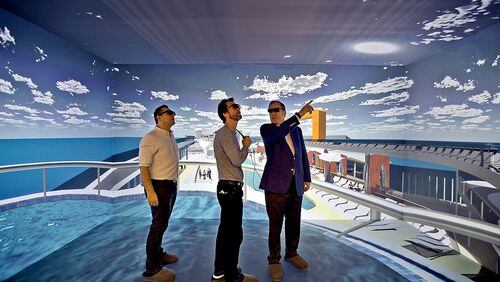Inside Royal Caribbean Cruises’ new Innovation Center called “The Cave,” executives, designers and architects can walk through a virtual cruise ship, granted their 3D goggles are on of course. The VR technology allows them to fine tune new features as simple as where to place tables in the rooftop garden and as radical as redefining the skeletal structure on the 2,900-passenger Celebrity Edge, scheduled in fall 2018.
That second shift facilitates a change especially important to Royal Caribbean Chairman Richard Fain: Bringing the sea closer to guests.
Borrowing a style found on some river-going ships, Celebrity has moved the ship’s skeleton from outside in, eliminating the thick steel balcony surrounds that block balcony views. With the balconies essentially inside the cabin, the space can be used for living indoors or as separate balcony, with an “infinity view” window across the entire space that slides down to create a glass railing and bi-folding French door to separate indoors and out.
“The beauty of this is what’s not here,” said Richard Fain, chairman and CEO of the parent company, Royal Caribbean Cruises.
The technology used to create the Edge, Celebrity’s first new class of ships since 2002, has all been used elsewhere, Fain said in a media preview to the line’s announcement. But bringing those features together in a PortMiami space within walking distance of executives’ offices — instead of a European shipyard — has led to a design that Fain likes to call “transformational.”
Case in point: The Magic Carpet.
The ship’s designers were looking to solve a common guest complaint: That the process for boarding the launches required to visit some small ports was crowded and cumbersome. Led by Tom Wright — the British architect behind the distinctive sail-shaped Burg Al Arab in Dubai — the team explored a half-dozen iterations before deciding on an elevated platform the size of a tennis court that can serve not as sea-level access point to the launches, but also as an oyster bar on the restaurant deck, a cocktail bar on the pool deck and a dinner venue on the top deck.
Some of the other new features are less radical but will directly address guest requests, said Celebrity president and CEO Lisa Lutoff-Perlo: larger cabins with bigger bathrooms, beds and storage.
On the technology front, Celebrity is introducing a number of new tools that continue the trend of Royal Caribbean’s WOW bands that open rooms and pay for services.
Guests on Celebrity will be able to check before their cruise via an app, much like guests do ahead of flights, allowing them to skip much of the traditional check-in process at ports. They will simply drop their luggage off curbside and walk in through new security portals linked to the app, allowing it to recognize each passenger.
Another first will be key-less entry, where guests can enter their staterooms by just using a digital key on their smart phones, also available on the Royal Caribbean app. Geo-location in cell phones allows the room to detect when a passenger is near and unlocks the room for them.
A new virtual concierge features that harnesses the same location technology so guests can order a drink for example, and staff will be able to take it to passengers — as long as they have their phones with them. Guests can also schedule activities on the concierge feature.
Staterooms themselves will be equipped with an automation feature that allows guests to adjust stateroom temperature and lights from a single touch pad.
The project follows several other technological announcement by cruise lines this year designed to enhance the guest experience.
In January, Doral-based Carnival Corp. became the first cruise line to incorporate smart technology with a sole focus on the experience, rather than stateroom upgrades or new architectural features. The company hired much of the team behind Disney’s MagicBand, a wrist band that unlocks features at Disney parks, to conceptualize a smart city.
The result: a quarter-size medallion emblazoned with each traveler’s name, ship and sail date that is connected to a complex network of sensors, readers, interactive screens and an app designed to introduce a personal touch in the cruising experience.
The medallion will first be rolled out on Carnival’s Princess Cruises line aboard the Regal Princess in mid-November from Fort Lauderdale.
Last week, Geneva-based MSC, which a ship that sails from Miami, announced a similar technology to Carnival’s during a news conference in Berlin.
The line’s new MSC for Me encompasses 130 different technological functions, the result of a three-year project in collaboration with brands including Deloitte Digital, Hewlett Packard Enterprise, Kodak and Samsung. The MSC iteration is a smart watch that also has geo-location (parents can see where there kids are at all times, for instance) and is attached to an app available for passengers and crew on mobile devices and stateroom TVs.
The MSC technology will debut in June on the MSC Meraviglia in Europe and in December on the MSC Seaside from PortMiami.
About the Author






